Low-impact exercises for seniors have become one of the most trusted approaches for maintaining lifelong mobility, strength, and overall wellness. Many older adults struggle with joint pain, stiffness, or reduced energy, which makes traditional workouts feel overwhelming or even risky. Low-impact exercises for seniors offer a gentler path that protects the joints while still delivering powerful benefits for the heart, muscles, and mind. These activities are ideal for anyone who wants to stay active without the strain that comes from high-intensity routines. In today’s fast-changing world, prioritizing safe, adaptable movement has never been more valuable.
Low-impact exercises for seniors are crafted to help older adults feel confident every time they move. These exercises involve smooth, controlled motions that put minimal pressure on the knees, hips, and back. This makes them accessible to individuals with arthritis, past injuries, or limited mobility. As more people recognize the importance of aging with strength and dignity, low-impact exercises continue to rise in popularity across communities, fitness programs, and senior wellness centers. The beauty of these exercises is that they adapt to every fitness level, which means anyone can begin right where they are.
Low-impact exercises for seniors also support emotional and mental health. Many seniors report greater clarity, reduced anxiety, and improved mood when they follow a consistent exercise routine. Gentle movement boosts circulation, enriches oxygen flow to the brain, and stimulates the release of natural feel-good hormones. This cultivates a sense of purpose and vitality, even during seasons of life when motivation may feel low. The goal is not perfection. The goal is progress. With low-impact exercises for seniors, that progress becomes realistic, enjoyable, and sustainable. 🌿
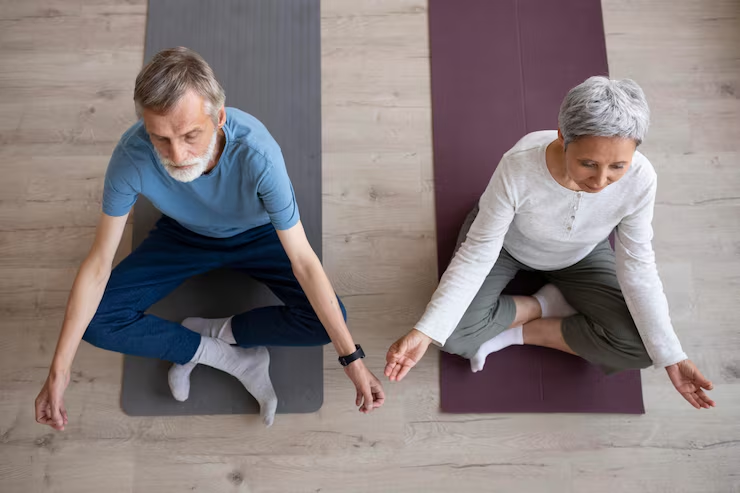
What Are Low-impact Exercises for Seniors?
Low-impact exercises for seniors refer to physical activities that minimize stress on the bones and joints while still providing meaningful health benefits. These exercises avoid harsh movements such as jumping, twisting, or pounding the ground. Instead, low-impact exercises for seniors prioritize balance, slow transitions, proper posture, and gentle resistance. These movements create a safe and supportive environment for older adults who want to stay active without feeling overwhelmed by physical intensity.
Low-impact exercises for seniors can be performed at home, outdoors, or at a local fitness center. Many of these routines require little to no equipment, which makes them affordable and convenient. Some examples include walking, water aerobics, Tai Chi, seated workouts, and controlled strength training. Each activity is designed to help seniors maintain independence and reduce the risk of falls or injuries. Many seniors prefer these exercises because they feel comfortable, natural, and manageable, even for beginners or those with limited mobility.
Low-impact exercises for seniors align perfectly with modern wellness guidelines that emphasize longevity, balance, and functional fitness. These exercises support daily activities such as standing, reaching, or bending. They also help seniors preserve muscle mass, which naturally declines with age. Most importantly, low-impact exercises for seniors encourage consistency. When an exercise routine feels safe and enjoyable, people are more likely to stay committed, which leads to long-term health improvements. This is why low-impact exercises for seniors continue to be one of the most recommended fitness choices for older adults worldwide.
Why Low-impact Exercises for Seniors Matter
Low-impact exercises for seniors matter because they help maintain physical independence. Many older adults worry about losing mobility or becoming dependent on others. Low-impact exercises for seniors work to prevent this by strengthening weak muscles, improving balance, and enhancing flexibility. Even small daily movements can slow age-related decline and improve confidence. Staying physically active gives seniors the ability to keep participating in life’s meaningful activities, from walking with loved ones to enjoying hobbies.
Low-impact exercises for seniors also play a key role in chronic disease management. Research continues to show that gentle movement improves circulation, stabilizes blood pressure, strengthens the heart, and helps regulate blood sugar. These benefits support individuals with conditions like arthritis, diabetes, or osteoporosis. Low-impact exercises for seniors also help reduce inflammation, which is a common contributor to pain. This creates a compound effect where movement becomes a natural form of relief instead of something that feels intimidating.
Low-impact exercises for seniors give emotional empowerment. Many seniors experience loneliness or anxiety as life circumstances change. Consistent movement boosts self-esteem, encourages social connection in group classes, and helps maintain a positive mindset. Simple routines can spark a renewed sense of purpose and joy. The goal is not to compete with others. The goal is to keep moving forward, slowly and steadily. Low-impact exercises for seniors make that process achievable while also enriching everyday life. 🌟
Top Low-impact Exercises for Seniors
Walking as Low-impact Exercises for Seniors 🚶♂️
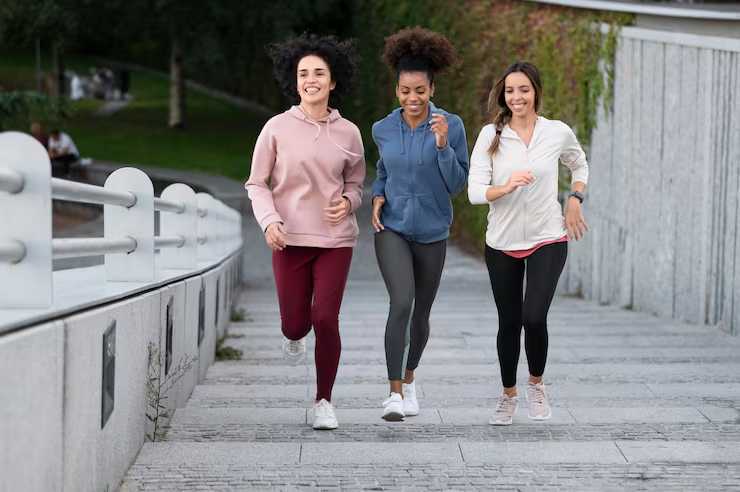
Walking is one of the simplest and most effective low-impact exercises for seniors. This activity requires no equipment, can be done anywhere, and naturally strengthens the heart and legs. Walking keeps joints mobile while reducing stiffness. Many seniors enjoy walking because it feels natural and does not require special training. It is also an excellent way to build a habit of movement without feeling overwhelmed. Walking can be done outdoors in fresh air or indoors for those who prefer comfort and safety.
Another powerful advantage of walking as one of the top low-impact exercises for seniors is its positive effect on mental health. Gentle walking improves circulation to the brain, which enhances memory and focus. Seniors who walk regularly often report better mood and deeper sleep. It is a simple way to clear the mind and reduce feelings of stress. Walking also creates opportunities for social bonding when done with friends or family members.
Walking supports long-term mobility and can help reduce the risk of chronic health problems. Regular steps strengthen the hips, knees, and ankles, which improves stability. Many seniors find that walking brings a renewed sense of independence because it keeps their bodies functional and strong.
How to Make It:
Start with 10 to 15 minutes of walking each day at a comfortable pace. Gradually increase time as endurance improves. Choose smooth surfaces and wear supportive shoes.
Nutritional Benefits:
Pair walking with hydration and light snacks like fruit or yogurt. This keeps energy stable and supports muscle recovery.
Swimming as Low-impact Exercises for Seniors 🏊♀️
Swimming is an ideal option among low-impact exercises for seniors because it offers full-body training without stressing the joints. Water naturally supports body weight, which makes movement feel lighter and smoother. Seniors with arthritis, balance limitations, or back pain often find swimming extremely comfortable. It strengthens the arms, legs, and core while keeping the heart strong. Swimming also increases flexibility due to the natural resistance of water.
Another benefit of swimming is improved lung health. As seniors develop a steady rhythm of breathing in the water, they enhance lung capacity and oxygen flow. This supports cardiovascular health and boosts energy levels. Swimming also helps reduce swelling in the joints, which is common in older adults. Consistency in this activity leads to improved posture and overall stamina.
Swimming creates a calming environment that supports emotional wellness. The rhythmic nature of movement in water offers a relaxing experience. Many seniors feel relieved from stress while swimming because the water eases tension in the muscles. Group classes can provide companionship and help seniors feel supported.
How to Make It:
Begin with water walking or simple strokes like freestyle or backstroke for 10 to 20 minutes. Increase time slowly as strength builds.
Nutritional Benefits:
Hydrate before entering the pool and consume light protein afterward such as eggs, tofu, or nuts to support muscle repair.
Chair Yoga as Low-impact Exercises for Seniors 🪑
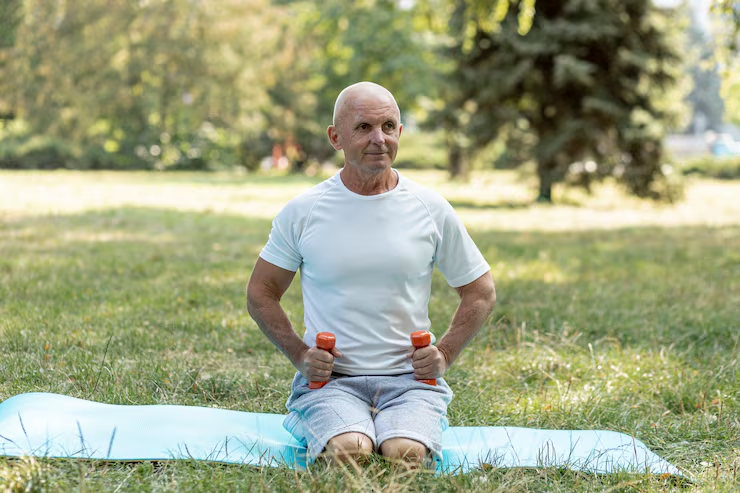
Chair yoga gives seniors a simple, relaxing way to stretch, improve balance, and release stress. This makes it one of the most accessible low-impact exercises for seniors. The movements are slow and controlled, which reduces the risk of injury. Seniors can sit or use the chair for support. Chair yoga increases joint flexibility and helps reduce back or leg discomfort.
Chair yoga also helps improve breathing patterns. Seniors practice deep, slow breaths, which increase oxygen flow and calm the nervous system. Many people find chair yoga meditative and grounding. It also helps increase circulation, which reduces swelling in the feet and ankles.
Chair yoga supports daily activities by strengthening the core and improving posture. It helps seniors stand, bend, and reach more comfortably. Many seniors find that chair yoga improves their confidence and reduces the fear of falling.
How to Make It:
Begin with simple stretches like seated twists, neck rolls, and supported leg lifts for 10 to 15 minutes.
Nutritional Benefits:
Light meals like oatmeal or bananas help maintain energy before yoga. Warm teas can aid relaxation afterward.
Tai Chi as Low-impact Exercises for Seniors 🌸
Tai Chi is known as a mindful movement practice that blends slow motions with controlled breathing. This makes it one of the most effective low-impact exercises for seniors. Tai Chi helps improve balance, focus, and coordination. The flowing motions strengthen the legs and core without strain. Many seniors find Tai Chi refreshing due to its calming rhythm.
Tai Chi also supports mental clarity. Seniors often feel more centered and relaxed after practicing. The slow, thoughtful movements reduce stress and encourage patience. Tai Chi also supports heart health because it maintains a steady, gentle pace.
Tai Chi reduces the risk of falls by strengthening stabilizing muscles. Seniors gain better control over their steps and improve posture. This boosts physical confidence and independence.
How to Make It:
Start with short sessions of basic movements and practice slow shifting from one foot to another.
Nutritional Benefits:
Light hydration and foods rich in antioxidants like berries or leafy greens support energy and joint health.
Resistance Band Training as Low-impact Exercises for Seniors 🏋️♂️

Resistance band workouts are excellent low-impact exercises for seniors who want to build strength safely. Bands provide gentle resistance and are easy to control. Training with bands strengthens the arms, legs, and core while keeping pressure off the joints. Seniors enjoy bands because they can adjust intensity easily.
Resistance band training also improves functional fitness. Stronger muscles support better posture and reduce back pain. Daily tasks like lifting objects, standing up, or climbing steps become easier. Seniors also benefit from higher bone strength when they use resistance regularly.
Resistance bands support circulation and flexibility. The smooth movements help increase mobility in the shoulders and hips. Many seniors also feel encouraged because progress is noticeable and steady.
How to Make It:
Perform exercises like seated rows, chest pulls, and leg extensions for 10 to 15 minutes.
Nutritional Benefits:
Protein-rich foods like beans, lean meats, or yogurt support muscle recovery after resistance training.
Stationary Cycling as Low-impact Exercises for Seniors 🚴
Stationary cycling offers gentle cardio that supports heart health without impacting the knees. This activity makes it one of the most reliable low-impact exercises for seniors. Cycling improves leg strength and enhances endurance. It also boosts circulation and reduces swelling.
Cycling gives seniors a stable, safe way to work out indoors. There is no risk of falling because the bike is stationary. Seniors can adjust the seat height and resistance to their comfort. The pedaling motion loosens stiff joints and makes movement feel smoother throughout the day.
Cycling supports weight control and helps regulate blood sugar. Many seniors report higher energy and fewer aches after consistent cycling. It also improves mood due to increased oxygen flow.
How to Make It:
Start with light pedaling for 10 minutes and gradually increase time.
Nutritional Benefits:
Hydrate well and enjoy balanced meals with carbohydrates and protein to support energy levels.
Water Aerobics as Low-impact Exercises for Seniors 💧
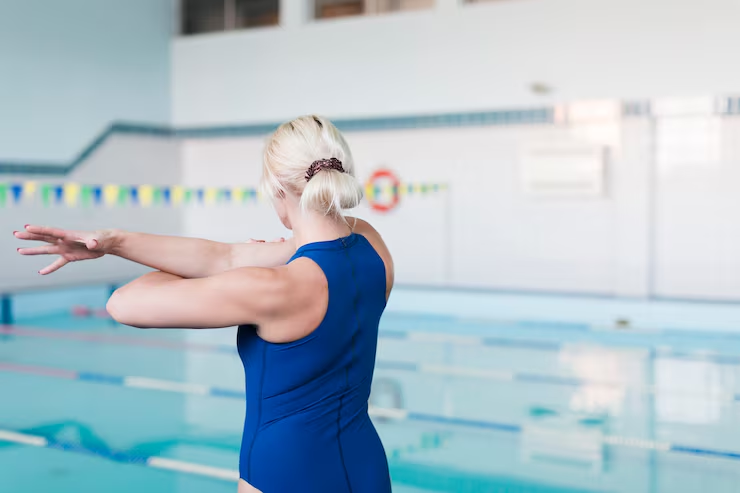
Water aerobics offers a full-body workout that feels gentle and refreshing. This makes it one of the most enjoyable low-impact exercises for seniors. Water supports the body and reduces pressure on the joints. Seniors can perform movements that might feel difficult on land.
Water aerobics improves cardiovascular health and builds muscle strength. The water adds natural resistance, which enhances calorie burn without strain. Many seniors feel lighter and more mobile in water, which encourages longer workouts.
Water aerobics also supports emotional well-being. The cool water relieves tension and helps relax the mind. Group classes create social support, which strengthens motivation.
How to Make It:
Join a local class or perform simple water movements like leg lifts and arm circles.
Nutritional Benefits:
Drink water before entering the pool and eat foods high in electrolytes like bananas or coconut water.
Pilates as Low-impact Exercises for Seniors 🧘♂️
Pilates focuses on improving core strength, posture, and flexibility. This makes it one of the most valuable low-impact exercises for seniors. Pilates supports spinal alignment and reduces back pain. The slow, controlled movements protect the joints.
Pilates helps seniors improve balance and coordination. Strengthening the core makes walking and standing safer. Seniors often notice improved flexibility after a few weeks of practice. Pilates encourages mindful movement, which reduces the risk of injury.
Pilates also supports deeper breathing. Seniors can reduce stress and increase focus. This helps improve mood and enhances confidence in daily movement.
How to Make It:
Start with beginner mat exercises like pelvic tilts or leg slides.
Nutritional Benefits:
Eat balanced meals with fiber and lean protein to maintain energy during sessions.
Conclusion
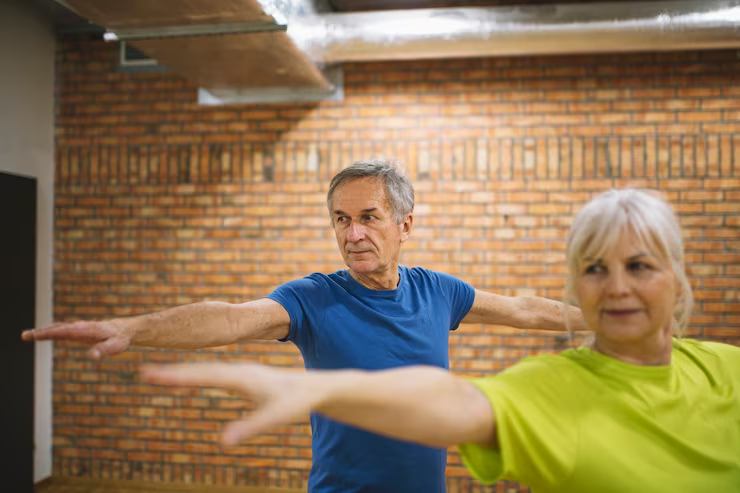
Low-impact exercises for seniors offer a powerful and practical pathway to health, mobility, and confidence. These gentle routines support strength, flexibility, balance, and endurance without causing strain on sensitive joints. Seniors can enjoy the freedom to move safely while improving their overall well-being. Low-impact exercises create opportunities to stay active at home, outdoors, or in group settings. This gives seniors the flexibility to choose routines that match their comfort level and lifestyle.
Low-impact exercises for seniors also encourage mental and emotional growth. Consistent movement sharpens focus, reduces stress, and boosts mood. Many seniors discover a renewed sense of purpose and joy when they commit to regular exercise. These routines help reduce loneliness by offering friendly group activities such as walking clubs, water aerobics classes, and Tai Chi groups. Seniors benefit from both the physical and emotional support that comes from staying active within a community.
Low-impact exercises for seniors empower individuals to maintain independence as they age. Movement strengthens the body in ways that support daily activities like climbing stairs, carrying groceries, and enjoying hobbies. Small actions produce long-term effects that enrich life quality. Seniors can build routines that bring steady, meaningful progress. The goal is always to move forward with confidence and dignity. With low-impact exercises for seniors, aging becomes a journey filled with strength, balance, and vitality. 🌟💚
FAQ’s
Q1. What makes low-impact exercises for seniors safer than other workouts?
Low-impact exercises for seniors are safer because they reduce stress on the joints and avoid harsh movements. These exercises support smooth transitions and controlled motions that protect vulnerable areas like the knees, hips, and back. Seniors can build strength and improve cardiovascular health without risking injuries or discomfort. This makes them ideal for long-term fitness.
Q2. How often should seniors perform low-impact exercises for the best results?
Seniors benefit most from low-impact exercises for seniors when they practice them at least three to five times per week. Consistency helps improve mobility, strength, and heart health. Seniors can start with short sessions and gradually increase duration. Regular activity improves energy levels and supports independence in daily life.
Q3. Can low-impact exercises for seniors help with arthritis pain?
Low-impact exercises for seniors are highly effective for managing arthritis pain. Gentle movements increase circulation, reduce inflammation, and lubricate the joints. This decreases stiffness and discomfort. Many seniors report better mobility and fewer flare-ups when they stay active. These exercises also strengthen muscles that support weakened joints.
Q4. Do seniors need equipment to perform low-impact exercises for seniors?
Most low-impact exercises for seniors require little to no equipment. Activities like walking, chair yoga, Tai Chi, and swimming only need comfortable clothing or supportive footwear. Some exercises, like resistance band workouts, use simple tools. Seniors can choose routines that match their comfort and budget.
Q5. Are low-impact exercises for seniors suitable for beginners?
Low-impact exercises for seniors are perfect for beginners because they are gentle and easy to follow. These exercises focus on slow, controlled movements that build confidence while protecting the joints. Seniors can start at their own pace and progress steadily. This approach makes fitness accessible for all experience levels.

